China's major archaeological discoveries were selected from the list of significant archaeological finds announced by the State Administration of Cultural Heritage (SACH) from 2011 to 2016.
Each year, 10 significant finds are selected from a group of candidates that date from the Paleolithic era to the Qing Dynasty (1644-1911). The selection is organized by the Archaeological Society of China and China Culture Relics Newspaper, and supervised by the State Administration of Cultural Heritage.
These major archaeological discoveries cover a rich variety of sites, ranging from the cemetery, kiln, Buddhist remains, a granary site and mining sites, and some of them are relatively rare archaeological findings. These discoveries provide crucial information and bring new perspective to academic research.
The following selection of China's major archaeological discoveries is listed according to chronological order from the Paleolithic era to the Qing Dynasty (1644-1911).
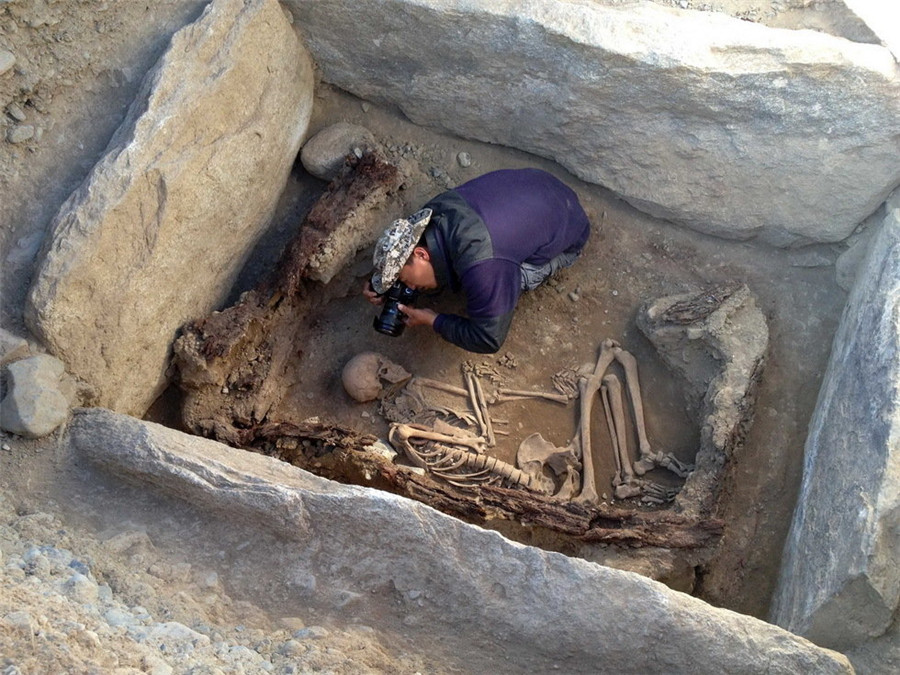 |
|
An archaeologist takes picture of a skeleton at the Adunqiaolu relic site in Wenquan, Xinjiang Uygur autonomous region [File photo/Xinhua] |
Adunqiaolu relic site and tombs in Wenquan, Xinjiang Uygur autonomous region
The Adunqiaolu site and tombs, located 41 kilometers west of Wenquan county of Northwest China's Xinjiang Uygur autonomous region, can be dated back to the Bronze Age (about 1800 BC in China).
While archeologists had previously found similar sites in areas of Kazakhstan and Russia, Adunqiaolu was the first for China.
Based on its scale and remains, the site might have functioned as a ritual center within the Bortala Valley or even further.
Large-scale stone architecture and tombs were of great significance in the exploration of early Bronze Age culture in the western Tianshan Mountain area.
From June to September 2012, archeologists excavated three linked houses and nine stone burial chambers, traced back to the 19th and 17th centuries BC.
The discovery of Adunqiaolu site provided important material for research into the cultural link between Northwest China and Central Asia during the Bronze Age.
Adunqiaolu relic site in Wenquan of Xinjiang Uygur autonomous region was listed as one of China's top 10 archaeological discoveries in 2012.
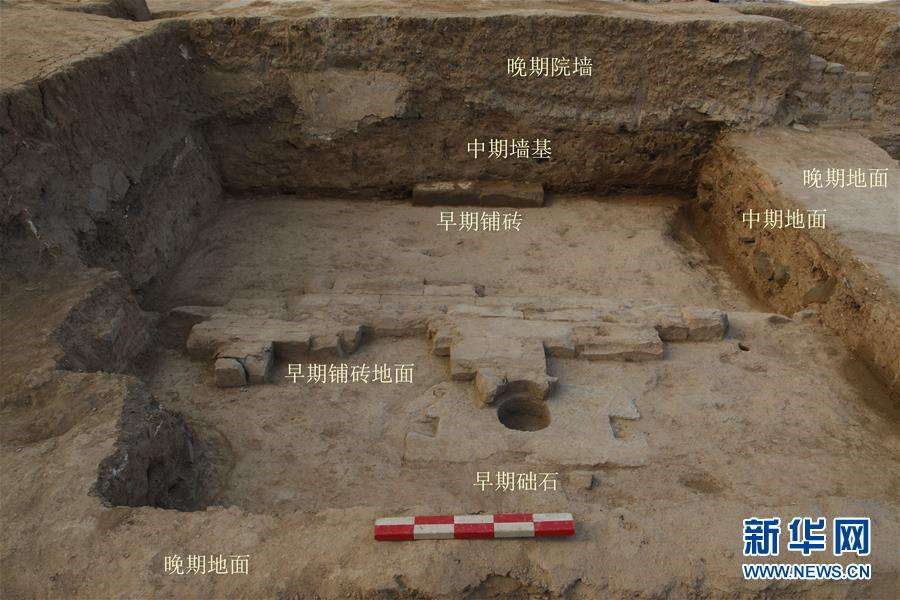 |
|
An excavation at the Taiji Hall at the imperial palace of the Han and Wei dynasties in Luoyang, Henan province. [File photo/Xinhua] |
Ruins of Taiji Hall of ancient Luoyang city, Henan province
The ruins of Taiji Hall in Luoyang city in Central China's Henan province are part of China's oldest palace.
The hall was the central part of the imperial palace of the Northern Wei Dynasty (386-557).
Archaeologists have cleared 3,000 square meters of the ruins and worked out the scale, range and structure of the palace building. They estimated that the original palace might have covered an area of 100,000 square meters.
Taiji Hall was composed of a central main hall and two side halls each in the east and west.
The palace building has been replicated ever since in building imperial palaces through the Sui, Tang, Song, Yuan, Ming and Qing dynasties, even spreading to East Asia and beyond. It played a significant role in the history of ancient capital.
Ruins of Taiji Hall of ancient Luoyang city in Henan province was listed among China's top 10 archaeological discoveries in 2015.
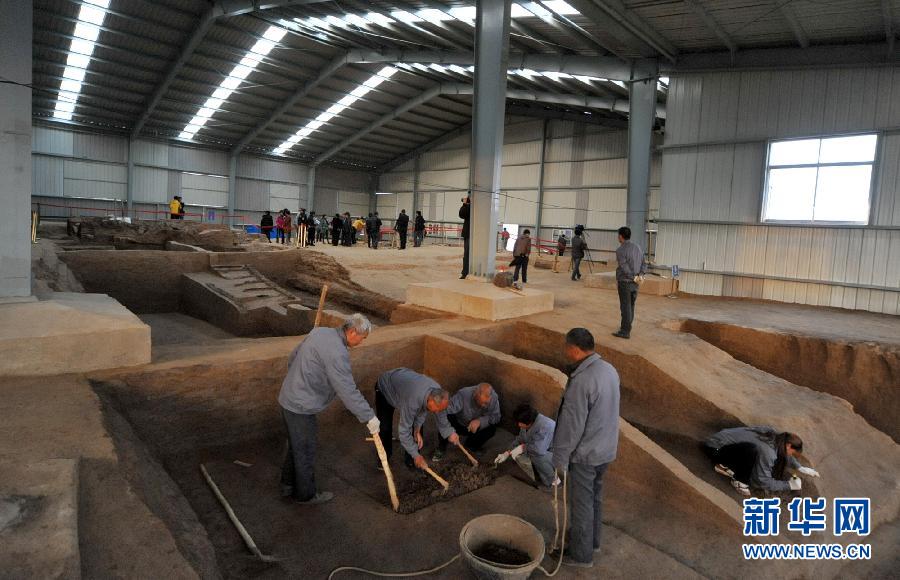 |
|
Tomb of Emperor Yang of Sui Dynasty. [File Photo/Xinhua] |
Tomb of Emperor Yang of the Sui Dynasty (AD 581-618) at Caozhuang in Yangzhou, Jiangsu province
The tomb was discovered at a construction site in Yangzhou, East China's Jiangsu province in 2013. It was a large earth mound 49 meters long from east to west and 48 meters wide from south to north. Under the mound, two burials were discovered.
A stone memorial tablet with the inscription "Sui Gu Yangdi" (deceased Emperor Yang of the Sui Dynasty) was found in burial M1, which proved its owner was Yang Guang, the second and last monarch of the short-lived Sui Dynasty.
Nearly 200 sets of burials offerings, including lion-shaped door knockers made of gold and iron and a jade belt decorated with gold, were unearthed, indicating the high status of the deceased.
The female deceased discovered in burial M2 under the same mound late proved be the queen of Emperor Yang.
The joint tombs offered material resources to the formation of advanced tombs in Sui and Tang dynasties. The high-standard burial goods from the tombs were extremely valuable to the study of history, politics, economy, and cultural of the Sui Dynasty.
According to historical material, Yang was killed during a mutiny in 618 AD, which marked the end of the Sui Dynasty.
Generally, Chinese historians say Yang's tyranny brought the Sui Dynasty (AD 581-618) to an end, but he also completed several great construction projects during his reign, including the Grand Canal and the reconstruction of the Great Wall.
Tomb of Emperor Yang of the Sui Dynasty in Yangzhou of Jiangsu province was listed as one of China's top 10 archaeological discoveries in 2013.
 |
|
Gold-coated small Asoka pagoda found among relics from Qinglong town, Qingpu district, Shanghai, Tang (618-907) to Song (960-1279) dynasties. [File Photo] |
Site of Qinglong town in Qingpu, Shanghai
A large number of ceramic and porcelain products from Tang to Song dynasties for trade were unearthed at the site of Qinglong town in suburban Shanghai's Qingpu district.
The artifacts unearthed indicated that the Qinglong town might be the earliest port in the current Shanghai area for overseas trade and an important start point of the maritime Silk Road.
The excavation found the base of the tower of the Longping Buddhist Temple, which was built in 1023-1032, a rare example of ancient Chinese Buddhism architecture.
The tower, standing in the northern tip of the ancient Qinglong town, was also used as a lighthouse, guiding busy commerce ships into the Wusong River harbor. Thus, it must have been the landmark of the port.
Artifacts discovered in the tower base include a King Asoka tower, a 4-layers box and more than 10,000 coins of different periods.
This archeological discovery revealed that Shanghai was an important harbor on the maritime Silk Road 1,000 years ago.
Site of Qinglong town in Qingpu of Shanghai was listed as one of China's top 10 archaeological discoveries in 2016.
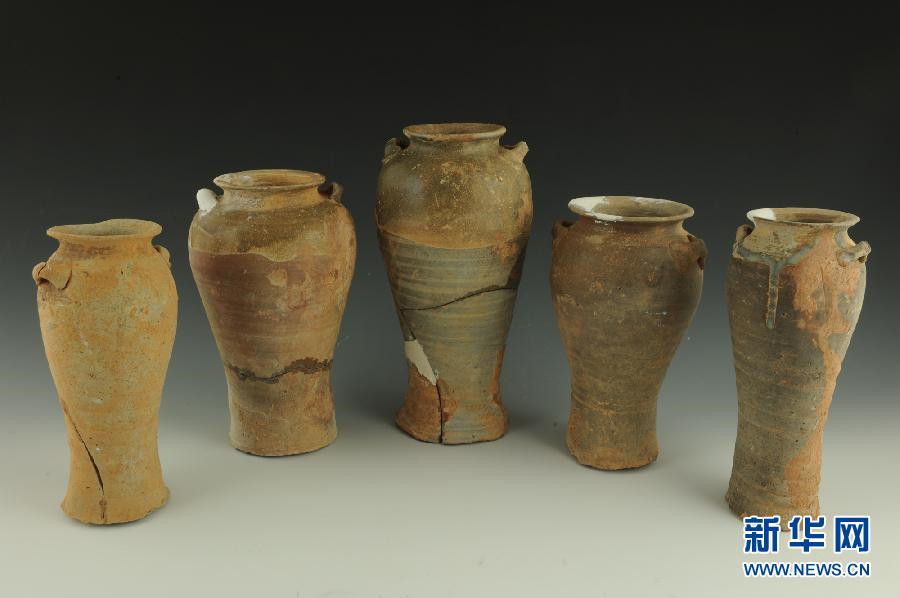 |
|
Ceramic glazed bottles from Nanyao porcelain furnace relics of Tang Dynasty (AD 608-917). [File Photo/Xinhua] |
Nanyao porcelain kilns of Tang Dynasty in Jingdezhen, Jiangxi province
A kiln site of 1013.5 square meters was discovered in 2013 at Nanyao village in Jingdezhen, East China's Jiangxi province.
Several sites have been excavated, including two dragon kilns, 11 ash pits, one ash furrow and one road site.
Nearly 10 tons of culture relics have been unearthed, including a large number of kiln furniture and tile chips.
Archaeologists concluded that the site could be dated back to the middle of the Tang Dynasty (766 - 835), more than 1,200 years ago.
The site was proved to be the earliest ceramic industry site discovered in Jingdezhen and pushed the history of porcelain in Jingdezhen back 200 years.
Nanyao porcelain kilns of Tang Dynasty in Jingdezhen of Jiangxi province was listed as one of China's top 10 archaeological discoveries in 2013.
 |
|
A stone carving from Shiqu rock engravings of Tubo Kingdom. [File photo/Xinhua] |
Shiqu rock engravings of Tubo Kingdom (7th to 9th century), Shiqu county, Sichuan province
Investigations on the early cliff carvings in Shiqu county in Southwest China's Sichuan province have been conducted by archaeologists from 2010 to 2013.
Three stone inscriptions remains including 18 units have been found respectively on the Xuba Holy Mountain, on the Baima Holy Mountain and in the Yanjiaocun village.
The carvings were preserved well, covering a rich variety of patterns including images of the Five Buddhas, Vairocana, Bodhisattvas, Tara and ancient Tibetan inscriptions, which were prevalent motifs of the Tubo kingdom.
Shiqu county was the first place in Sichuan where large area of Tubo carvings has been found. It provided new materials to study the ancient transportation roads between the Tang Empire and Tibet.
Besides, the discovery was of great significance to study Buddhism history of Tubo Kingdom, the relationship between Tang Dynasty and Tubo Kingdom, as well as the Buddhism's regional development on the Tibetan Plateau.
Shiqu rock engravings of Tubo Kingdom in Shiqu county of Sichuan province was listed as one of China's top 10 archaeological discoveries in 2013.
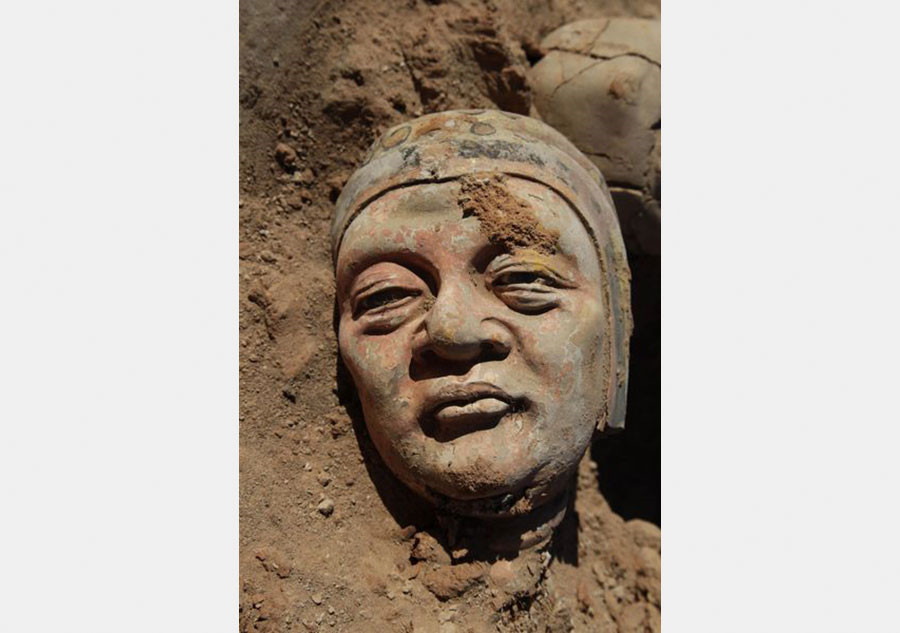 |
|
Clay sculpture of Buddha discovered in Inner Mongolia autonomous region [File Photo/Xinhua] |
Xishanpo Buddhist temple ruins in Inner Mongolia
Located to the south of Lindong town of Baarin Left Banner in North China's Inner Mongolia autonomous region, Liao Dynasty's upper-capital city Shangjing was first built in 918AD.
The city was consists of two parts, an imperial city area and a Han city area. Xishanpo Buddhist temple ruins were located within the Imperial City of the ancient Liao Dynasty (916-1125) capital.
To date, many precious relics have been excavated, including exquisite Buddhist clay sculptures, stone sculptures, copper coins, ceramic fragments and iron tools.
The important location and large scale of the temple ruins shows that it was one of the landmark architectures in Shangjing city.
The excavation of the ruins yielded abundant findings which could help to confirm the Xishanpo site to be a royal Buddhist monastery built during the Liao Dynasty.
Due to its important location and large size, the temple could be rated as one of landmarks in ancient capital city.
The discovery also provided invaluable materials to study the history, Buddhism and architecture of the Liao Dynasty.
Xishanpo Buddhist temple site in Inner Mongolia was listed as one of China's top 10 archaeological discoveries in 2012.
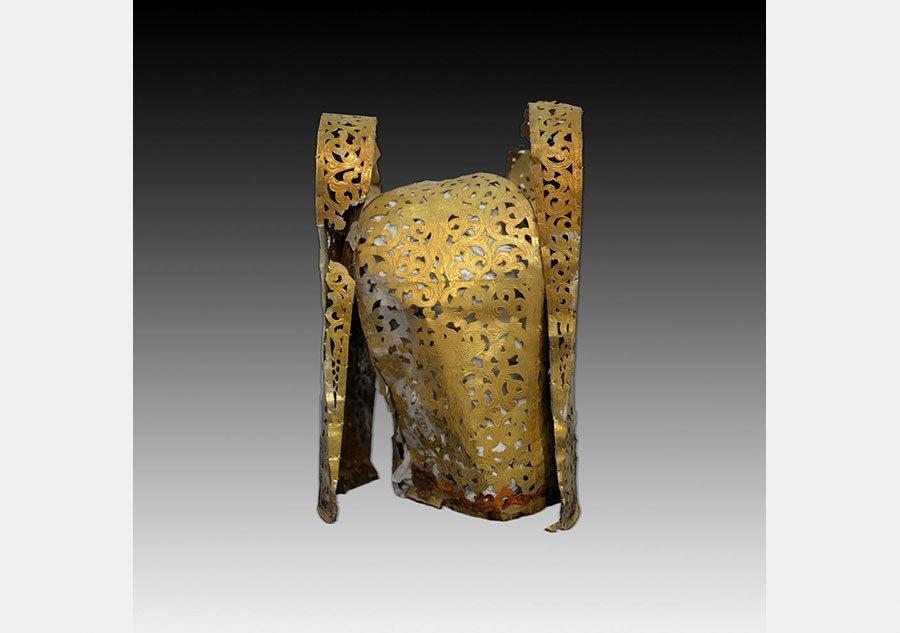 |
|
A golden crown unearthed from the Liao Dynasty imperial concubine tomb in North China's Inner Mongolia. [File photo] |
Liao Dynasty imperial concubine tomb in Inner Mongolia
Tombs found in North China's Inner Mongolia autonomous region were believed to be those of an imperial concubine from the Liao Dynasty (916-1125) and her family.
Lavish articles for daily use by the royal family, such as silk, amber, jadeware, and silver objects, were unearthed from the tomb.
Five pieces of glassware uneathed were believed to be originated in the Middle East, which suggested contact between China and the Arab world at the time.
An inscription discovered in one of the tombs indicated that it must have belonged to the concubine of Emperor Yelu Longxu, who was later demoted in a power struggle.
Liao Dynasty imperial concubine tomb in Inner Mongolia was listed as one of China's top 10 archaeological discoveries in 2015.
 |
|
An aerial view of Hailongtun Fortress in Zunyi, Guizhou province. [File photo/Xinhua] |
Hailongtun Fortress Site in Zunyi, Guizhou province
Located on Longyan Mountain, about 30 kilometers north of the old city of Zunyi in Southwest China's Guizhou province, Hailongtun Fortress Site is the best well-preserved medieval castle ruins in China.
The Hailongtun fortress was constructed by the Bozhou Tusi government in 257 during the Southern Song Dynasty (1127-1279) and destroyed during the war against Ming Dynasty rule in 1600.
The fortress consisted of nine passes and covers an area of two square kilometers. It was surrounded by cliffs on all four sides with only one entrance from the mountain road.
The term Tusi refers to local minority chieftains during Song, Yuan and Ming dynasties. For hundreds of years, imperial officials governed remote areas and borderlands via such hereditary leaders.
Hailongtun fortress provided important clues to study the development of Tusi System and the architecture featuring unique characteristics.
Hailongtun Fortress Site in Zuiyi of Guizhou province was listed as one of China's top 10 archaeological discoveries in 2012, and together with the other two Tusi sites, it was added to UNESCO's World Heritage List in 2015.
 |
|
Archaeologists measure shipwreck of the Zhiyuan, which was sunk by the Japanese navy during the first Sino-Japanese War in 1894, in Liaoning province. [File photo/Xinhua] |
Warship sunk during Sino-Japanese War in the Yellow Sea
Significant discoveries of the shipwreck "Dandong No.1" of Qing Dynasty in Liaoning province have been made in 2015.
The shipwreck found in the Yellow Sea was finally confirmed to be the cruiser Zhiyuan, sunk by the Japanese navy 122 years ago during the Sino-Japanese War in the Dandong sea area of north part of the Yellow Sea.
The 50-meter wreck was about 10 nautical miles southwest of Dandong Port in Northeast China's Liaoning province, at a depth of around 20 meters.
Zhiyuan, built in Britain in 1887, was one of the most advanced warships in the Beiyang Fleet, defeated in 1894 by the Japanese navy.
Severely damaged in the battle, the ship was not well preserved. Divers have retrieved more than 120 items from the seabed, including a porthole, machine gun, shells, and dinnerware bearing the characters "Zhiyuan", strong evidence pointing to the ship's identity.
It was an important underwater archaeological discovery in China, which provided precious archaeological materials for the investigation of the history of the Sino-Japanese War and the world naval history.
Warship sunk during Sino-Japanese War in the Yellow Sea was listed as one of China's top 10 archaeological discoveries in 2015.

Presented by Chinadaily.com.cn Registration Number: 10023870-7
Copyright © Ministry of Culture, P.R.China. All rights reserved